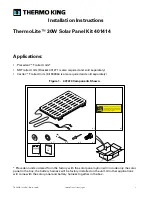
www.etsolar.hk
- 2 -
extension cables to simplify module wiring.
Each individual module can generate DC voltages greater than 30 volts (V)
when exposed to direct sunlight. Contact with a DC voltage of 30 V or more is
potentially hazardous. Exercise caution when wiring or handling modules
exposed to sunlight.
When disconnecting wires connected to a photovoltaic module that is
exposed to sunlight, an electric arc may occur. Arcs can cause burns, start
fires or otherwise create safety problems. Exercise caution when
disconnecting wiring on modules exposed to sunlight.
Photovoltaic solar modules convert light energy to direct-current electrical
energy, and are designed for outdoor use. Proper design of support structures
is the responsibility of the system designer and installer.
Modules may be ground mounted, pole mounted, or mounted on rooftops.
Do not apply paint or adhesive to the module.
When installing modules, observe all applicable local, regional and national
codes and regulations. Obtain a building and/or electrical permit where
required.
Storage Temperature:-10
℃~
40
℃
, Storage Humidity:≤70%RH;
Modules should operate at environmental temperature of between -40 to
+85
℃
. If modules are to be installed in areas where the temperature may go
outside the above range, please consult with ET Solar before installation.
The irradiance reflected on the rear of the bifacial solar modules shall not
exceed 300W/m
2
.
Do not attempt to disassemble the module, and do not remove any
attached nameplates or components. Doing so will void the warranty.
Do not use mirrors or other hardware to artificially concentrate sunlight on
the module.
3.1
Safety precautions for installing a solar photovoltaic system
Regular safety: ET Solar Modules are designed to meet the requirement of IEC 61215
and IEC61730, application class A. Modules rated for use in this application class
may be used in system operating at greater than 50VDC or 240W, where general
contact access in anticipated. Modules qualified for safety through IEC61730-
1,61730-2 and within this application class are considered to meet the requirement
for protection class II equipment.
Solar modules produce electrical energy when exposed to sunlight. DC
voltages may exceed 30V on a single exposed module.
Only connect modules with the same rated output current in series. If modules
are connected in series, the total voltage is equal to the sum of the individual
module voltages. The maximum system voltage for module type is
1500V(IEC/UL), for roof use, the maximum system voltage must not exceed
1000V according to National Electrical Code.
Bypass diodes are preassembled in each module. Do not remove these diodes.
1





































